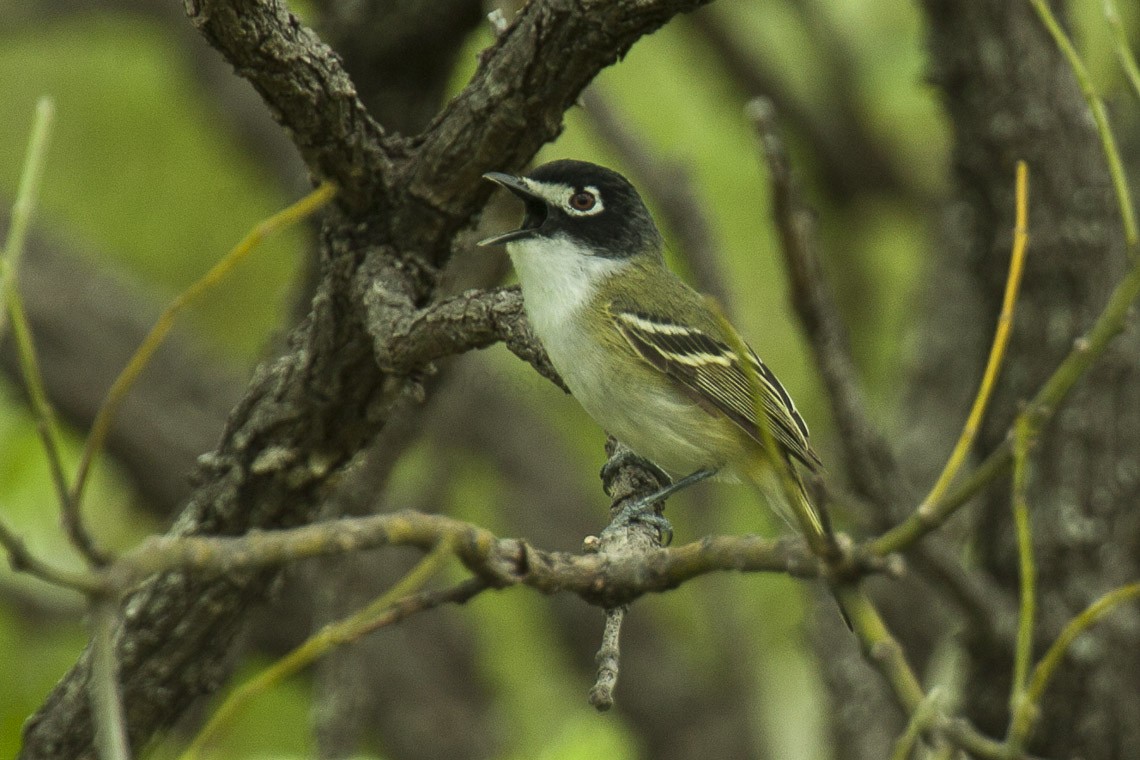Black-capped Vireo
A species of Vireos Scientific name : Vireo atricapilla Genus : Vireos
Black-capped Vireo, A species of Vireos
Botanical name: Vireo atricapilla
Genus: Vireos
Content
Description General Info
 Photo By Francesco Veronesi , used under CC-BY-SA-2.0 /Cropped and compressed from original
Photo By Francesco Veronesi , used under CC-BY-SA-2.0 /Cropped and compressed from original Description
The black-capped vireo is a songbird about 12 cm (4.5 inches ) in length. Sexually mature males are olive green above and white below with faint yellow flanks. The crown and upper half of the head is black with a partial white eye-ring and lores. The iris is brownish-red and the bill is black. Females are duller in color than males and have a slate-gray crown and underparts washed with greenish yellow. First year males often (but do not always) have more extensive gray in the cap, similar to adult females. 
Size
10-12 cm (4-4.75 in)
Life Expectancy
5-8 years
Nest Placement
Tree
Clutch Size
2 - 5 eggs
Feeding Habits
Black-capped Vireo primarily consume insects and larvae from foliage, often in oak trees, employing techniques like hovering or hanging upside-down. Their prey includes moths, beetles, flies, katydids, spiders, with a preference for the upper tree canopy. Some plant matter, such as berries, supplements their diet.
Habitat
Black-capped Vireo primarily dwells in oak scrub and brushy hillsides with low, varied vegetation, preferring oaks like blackjack and plateau live oaks. They inhabit areas with sandy or rocky soils, ravines, or canyons and require disturbed environments for nest-building in dense scrub. Their habitat extends to arid regions, taller woodlands, and stream corridors post-breeding, and in winter, black-capped Vireo migrates to western Mexico's arid foothills and canyons.
Nest Behavior
Both black-capped Vireo genders select the site, but only the female builds the actual egg nest. Initial structures are made by males. Nesting includes continual construction by the female, followed by egg-laying, with both parents providing care for the offspring.
Nest Characteristics
The black-capped Vireo's nest is an open cup constructed mainly by females with leaves, grasses, plant fibers, and lined with soft materials. It's camouflaged using paper, string, and other debris, measuring about 2.2 inches wide and 2.3 inches tall, placed in shrubbery around 3 feet high.
Dite type
Insectivorous
General Info
Feeding Habits
Bird food type
Bird Feeder Type

Small Hopper

Small Tube Feeder
Sounds
Song
Recording location: Mexico
Behavior
The black-capped Vireo exhibits a vibrant daily routine, initiating with male black-capped Vireo's early arrival at breeding grounds to claim territories through vigorous song and defense maneuvers, sometimes even engaging in high aerial chases. The size of their territorial claims can vary widely. Females play a crucial role in mate selection, considering both the suitor's qualities and his territory before engaging. Males entice females through an elaborate courtship involving both visual and auditory displays, including wing quivering and a distinctive fluffing of body feathers, revealing a vivid underwing pattern. Post-mating, males vigilantly guard their mates until egg-laying commences. Black-capped Vireo showcase a complex mating system where relationships are not strictly monogamous, and both sexes may engage with multiple partners within a breeding season. Post-hatching, young black-capped Vireo males may be tolerated within a territory, and as breeding season concludes, black-capped Vireo typically revert to solitary foraging, dismantling any potential family groups.
Distribution Area
The historic breeding distribution of the black-capped vireo extended south from south-central Kansas through central Oklahoma and Texas to central Coahuila, Mexico. At present, the range extends from Oklahoma south through the Edwards Plateau and Big Bend National Park, Texas, to at least the Sierra Madera in central Coahuila, Mexico. In Oklahoma, the black-capped vireo is found only in Blaine, Cleveland, Cotton and Comanche counties. The winter range of this vireo is not well known. It is thought to winter along the west coast of Mexico from southern Sonora to Guerrero. 
Species Status
The black-capped vireo is threatened by brown-headed cowbird (Molothrus ater) brood parasitism, human disturbance, and loss of habitat to urbanization, fire exclusion, grazing, and brush control. With population sizes now well into the tens of thousands, the species continues to be managed by the Texas Parks and Wildlife Department and the Oklahoma Department of Conservation. Conservation efforts by the U.S. Army are continuing to enhance the conservation status of the black-capped vireo. 
Scientific Classification
Phylum
Chordates Class
Birds Order
Perching birds Family
Vireos Genus
Vireos Species
Black-capped Vireo